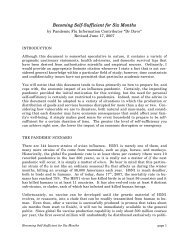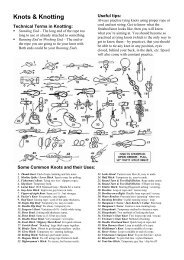Knots, Splices, Attachments, and Ladders Section I. Knots, Hitches ...
Knots, Splices, Attachments, and Ladders Section I. Knots, Hitches ...
Knots, Splices, Attachments, and Ladders Section I. Knots, Hitches ...
You also want an ePaper? Increase the reach of your titles
YUMPU automatically turns print PDFs into web optimized ePapers that Google loves.
FM 5-125<br />
one rope into the side of another. As a per- The ropes to be joined should be the same<br />
manent loop or eye, no knot can compare<br />
with this splice for neatness <strong>and</strong> efficiency.<br />
LONG SPLICE<br />
Use the long splice when the larger diameter<br />
of the short splice has an adverse effect on<br />
the use of the rope; use it also to splice long<br />
ropes that operate under heavy stress (see<br />
Figure 2-42). This splice is as strong as the<br />
rope itself. A skillfully made long splice will<br />
run through sheaves without any difficulty.<br />
2-28 <strong>Knots</strong>, <strong>Splices</strong>, <strong>Attachments</strong>, <strong>and</strong> <strong>Ladders</strong><br />
lay <strong>and</strong> as nearly the same diameter as<br />
possible.<br />
CROWN OR BACK SPLICE<br />
When you are splicing the end of a rope to<br />
prevent unlaying, <strong>and</strong> a slight enlargement<br />
of the end is not objectionable, use a<br />
crown splice to do this (see Figure 2-43,<br />
page 2-30). Do not put any length of rope<br />
into service without properly preparing the<br />
ends.
















